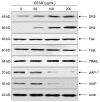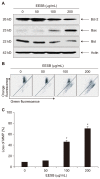Induction of Apoptosis Scutellaria baicalensis Georgi Root Extract by Inactivation of the Phosphatidyl Inositol 3-kinase/Akt Signaling Pathway in Human Leukemia U937 Cells
- PMID: 30993090
- PMCID: PMC6453591
- DOI: 10.15430/JCP.2019.24.1.11
Induction of Apoptosis Scutellaria baicalensis Georgi Root Extract by Inactivation of the Phosphatidyl Inositol 3-kinase/Akt Signaling Pathway in Human Leukemia U937 Cells
Abstract
Background: The roots of Scutellaria baicalensis Georgi (Labiatae) have been widely used in traditional medicine for treatment of various diseases. In this study, we investigated the effects of ethanol extracts of S. baicalensis roots (EESB) on the growth ofn human leukemia U937 cells.
Methods: The effect of EESB on cell viability was measured by the 3-(4,5-dimethyl-2-thiazolyl)-2,5-diphenyl-2H-tetrazolium bromide assay. Apoptosis was determined using 4,6-diamidino-2-phenyllindile staining and flow cytometry. The effects of EESB on the expression of regulatory proteins of apoptosis and phosphatidyl inositol 3-kinase (PI3K)/Akt signaling were determined by Western blotting. Caspase activity and mitochondrial membrane potential (MMP) were measured using flow cytometric analysis.
Results: EESB significantly inhibited the growth of U937 cells and induced apoptosis, which was associated with down-regulation of anti-apoptotic Bcl-2, up-regulation of pro-apoptotic Bax, the loss of MMP and activation of caspase-9 and -3. We also found that EESB enhanced the expression of death receptors (DRs) and their associated ligands and induced the activation of caspase-8 and truncation of Bid. In addition, EESB suppressed PI3K/Akt signaling and EESB-induced apoptosis and growth inhibition were further increased by inhibition of PI3K activity.
Conclusions: Our results indicated that the pro-apoptotic effect of EESB was mediated through the activation of DR-mediated intrinsic and mitochondria-mediated extrinsic apoptosis pathways and inhibition of the PI3K/Akt signaling in U937 cells.
Keywords: Apoptosis; Caspase; PI3K/Akt; Scutellaria baicalensis; U937 cells.
Conflict of interest statement
CONFLICTS OF INTEREST No potential conflicts of interest were disclosed.
Figures







Similar articles
-
Induction of apoptosis by Dae-Hwang-Mok-Dan-Tang in HCT-116 colon cancer cells through activation of caspases and inactivation of the phosphatidylinositol 3-kinase/Akt signaling.Integr Med Res. 2017 Jun;6(2):179-189. doi: 10.1016/j.imr.2017.03.003. Epub 2017 May 26. Integr Med Res. 2017. PMID: 28664141 Free PMC article.
-
So-Cheong-Ryong-Tang induces apoptosis through activation of the intrinsic and extrinsic apoptosis pathways, and inhibition of the PI3K/Akt signaling pathway in non-small-cell lung cancer A549 cells.BMC Complement Altern Med. 2015 Apr 10;15:113. doi: 10.1186/s12906-015-0639-y. BMC Complement Altern Med. 2015. PMID: 25889185 Free PMC article.
-
Scutellaria barbata D. Don inhibits colorectal cancer growth via suppression of Wnt/β-catenin signaling pathway.Chin J Integr Med. 2017 Nov;23(11):858-863. doi: 10.1007/s11655-017-2775-3. Epub 2017 Oct 28. Chin J Integr Med. 2017. PMID: 29080197
-
Acacia catechu (L.f.) Willd and Scutellaria baicalensis Georgi extracts suppress LPS-induced pro-inflammatory responses through NF-кB, MAPK, and PI3K-Akt signaling pathways in alveolar epithelial type II cells.Phytother Res. 2019 Dec;33(12):3251-3260. doi: 10.1002/ptr.6499. Epub 2019 Sep 10. Phytother Res. 2019. PMID: 31506998
-
Molecular mechanisms of ZD1839 (Iressa)-induced apoptosis in human leukemic U937 cells.Acta Pharmacol Sin. 2007 Aug;28(8):1205-14. doi: 10.1111/j.1745-7254.2007.00615.x. Acta Pharmacol Sin. 2007. PMID: 17640484
Cited by
-
The Role of Natural Products in the Improvement of Cancer-Associated Cachexia.Int J Mol Sci. 2023 May 15;24(10):8772. doi: 10.3390/ijms24108772. Int J Mol Sci. 2023. PMID: 37240117 Free PMC article. Review.
References
LinkOut - more resources
Full Text Sources
Research Materials
